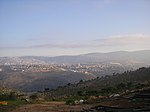| Revision as of 01:45, 21 May 2023 editTurnagra (talk | contribs)Autopatrolled, Extended confirmed users7,616 editsNo edit summary← Previous edit | Revision as of 06:58, 19 July 2023 edit undoGilabrand (talk | contribs)Extended confirmed users72,084 edits +imageNext edit → | ||
| Line 5: | Line 5: | ||
| |native_name={{native name list|tag1=he |name1=הגליל העליון |italics1=no|tag2=ar |name2=الجليل الأعلى |italics2=no}} | |native_name={{native name list|tag1=he |name1=הגליל העליון |italics1=no|tag2=ar |name2=الجليل الأعلى |italics2=no}} | ||
| |highest_point=] | |highest_point=] | ||
| |photo= |
|photo=File:Lemon Orchard in the Galilee by David Shankbone.jpg | ||
| |photo_caption= |
|photo_caption= | ||
| |image_map= | |image_map= | ||
| |coordinates={{coord|32|59|N|35|24|E|type:region|display=inline,title}} | |coordinates={{coord|32|59|N|35|24|E|type:region|display=inline,title}} | ||
Revision as of 06:58, 19 July 2023
Regional area in northern Israel| Upper Galilee | |
|---|---|
| Region | |
 | |
| Coordinates: 32°59′N 35°24′E / 32.983°N 35.400°E / 32.983; 35.400 | |
| Part of | Israel |
| Native name | |
| Highest elevation | 1,208 m (3,963 ft) (Mount Meron) |
The Upper Galilee (Template:Lang-he, HaGalil Ha'Elyon; Template:Lang-ar, Al Jaleel Al A'alaa) is a geographical-political term in use since the end of the Second Temple period. It originally referred to a mountainous area straddling what today is northern Israel and southern Lebanon. The boundaries of this area were the Litani River in the north, the Mediterranean Sea in the west, the Lower Galilee in the south (from which it is separated by the Beit HaKerem Valley), and the upper Jordan River and the Hula Valley in the east. According to the 1st-century historian Josephus, the bounds of Upper Galilee stretched from Bersabe in the Beit HaKerem Valley to Baca (Peki'in) in the north. The extent of this region is approximately 470 km.
However, in present-day Israeli usage, the toponym mainly refers only to the northern part of the Galilee that is under Israeli sovereignty. That is, the term today does not include the portion of Southern Lebanon up to the Litani River, or the corresponding stretches of the Israeli Coastal Plain to the west, or the Jordan Rift Valley to the east. These are considered to be separate geographical areas that are not part of “Upper Galilee.”
History
| This section needs additional citations for verification. Please help improve this article by adding citations to reliable sources in this section. Unsourced material may be challenged and removed. (January 2022) (Learn how and when to remove this message) |

Following the dissolution of the Ottoman Empire and the Balfour Declaration in which the British Empire promised to create "A Jewish National Home" in Palestine, the Zionist Movement presented to the Versailles Peace Conference a document calling for including in the British Mandate of Palestine the entire territory up to the Litani river — with a view to this becoming eventually part of a future Jewish state.
However, only less than half this area was actually included in British Mandatory Palestine, the final border being influenced both by diplomatic maneuverings and struggles between Britain and France and by fighting on the ground, especially the March 1920 battle of Tel Hai.
For a considerable time after the border was defined so to make the northern portion of the territory concerned part of the French mandated territory that became Lebanon, many Zionist geographers — and Israeli geographers in the state's early years — continued to speak of "The Upper Galilee" as being "the northern sub-area of the Galilee region of Israel and Lebanon".
Under this definition, "The Upper Galilee" covers an area spreading over 1,500 km, about 700 in Israel and the rest in Lebanon. This included the highland region of Belad Bechara in Jabal Amel located in South Lebanon, which was at for some time known in Hebrew as "The Lebanese Galilee". As defined in geographical terms, "it is separated from the Lower Galilee by the Beit HaKerem valley; its mountains are taller and valleys are deeper than those in the Lower Galilee; its tallest peak is Har Meron at 1,208 m above sea level. Safed is one of the major cities in this region".
In recent decades, however, this usage has virtually disappeared from the general Israeli discourse, the term "Upper Galilee" being used solely in reference to the part located in Israel.
 A panoramic view taken from mount Ari in the Upper Galilee towards the Lower Galilee
A panoramic view taken from mount Ari in the Upper Galilee towards the Lower Galilee
Gallery
-
Mountainous area in the Upper Galilee
-
 Ain Ebel in the Lebanese Upper Galilee
Ain Ebel in the Lebanese Upper Galilee
-
 A view looking north from the top of Har Meron in the Upper Galilee. Parts of southern Lebanon are visible in the background
A view looking north from the top of Har Meron in the Upper Galilee. Parts of southern Lebanon are visible in the background
-
Old road from Rosh Pinna to Safed, Upper Galilee, Israel
-
The Keshet Cave (a natural arch) located on a ridge near Nahal Betzet
-
 An orchard in Upper Galilee
An orchard in Upper Galilee
-
The Amud river
-
 Safed
Safed
-
 Karmiel
Karmiel
-
Horses roam in Amud stream, near the Sea of Galilee
See also
References
- ^ Vilnai, Ze'ev (1976). "Upper Galilee". Ariel Encyclopedia (in Hebrew). Vol. 2. Israel: Am Oved. pp. 1364–67.
- M. Aviam & P. Richardson, "Josephus' Galilee in Archaeological Perspective", published in: Mason, Steve, ed. (2001). Life of Josephus. Flavius Josephus: Translation and Commentary. Vol. 9. BRILL. pp. 179;182. ISBN 9004117938.; Josephus, De Bello Judaico (Wars of the Jews) II, 577; III, 46 (Wars of the Jews 3.3.1)
- Erich M. Meyers, "Galilean Regionalism as a Factor in Historical Reconstruction," in: Bulletin of the American Schools of Oriental Research (No. 221, 1976), p. 95
- Salibi, Kamal S. (1988). A House of Many Mansions: The History of Lebanon Reconsidered. London: I.B. Tauris. p. 4. ISBN 1-85043-091-8.